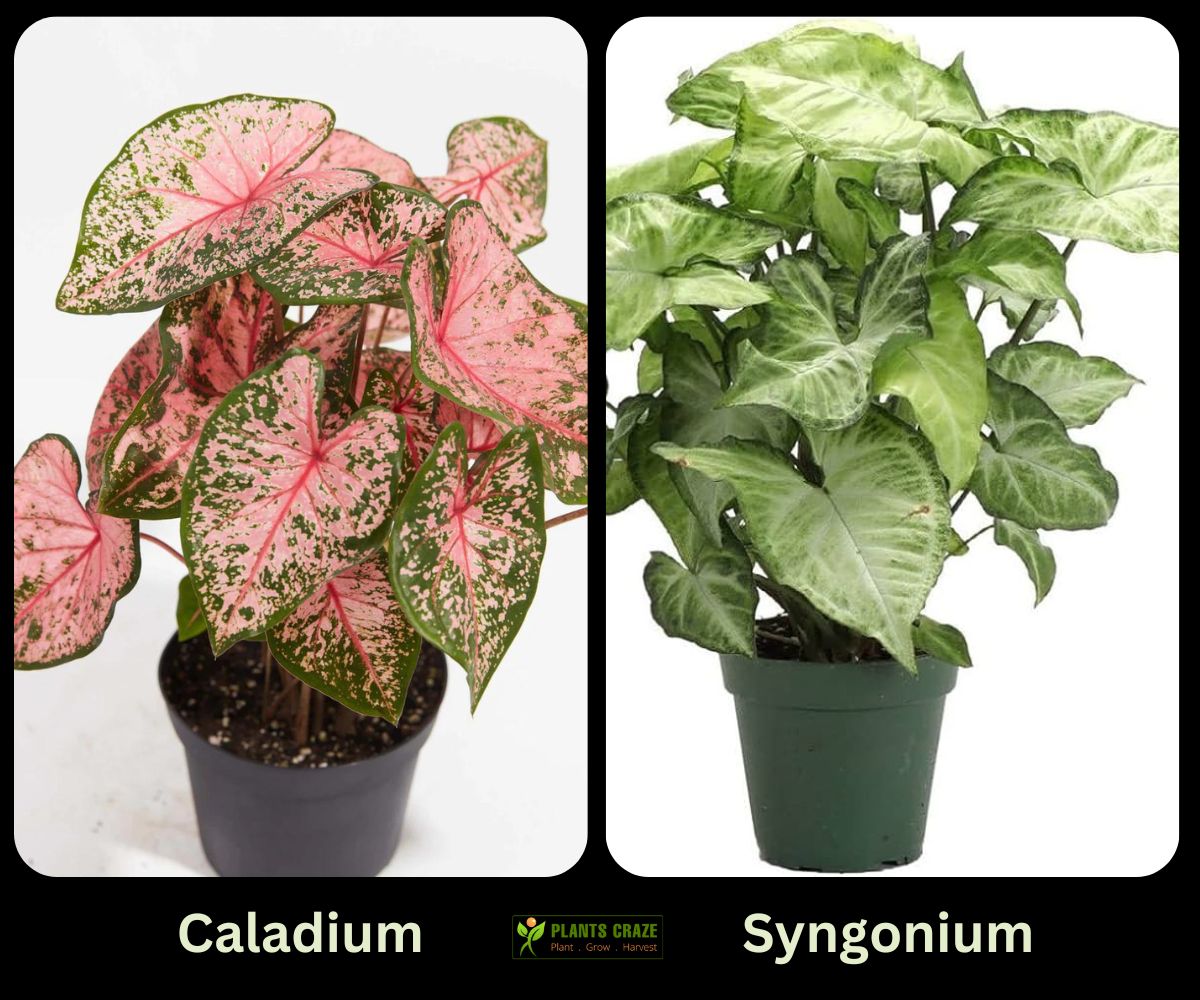If you want to buy one of the two aroids, Caladium and Syngonium, online, you must distinguish one vs another as both have different requirements.
So, go through this complete article to know the potential difference between two similar-looking plants, Caladium and Syngonium, to fit them according to your living spaces.
Table of Contents Show
Caladium Vs Syngonium [Similarities]
Caladium and Syngonium are low-maintenance indoor plants. Both bear wide, flaring foliage with great ornamental value.

Additionally, both houseplants belong to a similar family, Araceae, which is also called the Arum family.
- Both plants are aroids, which are divided into spathe and spadix.
- Moreover, you can see the distinct heart-shaped variegated leaves in both varieties.
- Both varieties are native to the tropical rainforests of Central and South America.
- Parts of both varieties are mildly toxic to pets and humans upon consumption.
- Also, both varieties prefer to thrive in locations with moderate to high humidity.
- Both fit in the indoor location with low light conditions.
- You can propagate both varieties using divisions, stem cuttings, and leaf sections.
Caladium Vs Syngonium [5+ Differences]
Caladium is an ornamental houseplant belonging to the genus Caladium. In contrast, Syngonium belongs to the genus Syngonium.
Moreover, people often recognize Caladium by the names Elephant Ear or Angel Wings due to its wide, fan-shaped leaves.
Meanwhile, the common name of Syngonium is Arrowhead Vine due to the pointed, arrowhead-shaped foliage.
1. Plant Appearance
The leaves of Caladium are bigger than Syngonium. The color of the leaves in Caladium varies in white, green, pink, red, etc, giving the plant an appealing look.
Meanwhile, Syngonium is less appealing and usually bears green foliage with lighter or whiter variegation.
The texture of the leaves in Caladium is smooth and glossy, unlike Syngonium, with rough and matte leaves.
Moreover, Caladium contains a tuberous root system, while Syngonium has an adventitious root system.
2. Growth Habits
Caladium has compact and bushy growth habits, whereas Syngonium grows as a vining plant or climber. Additionally, the growth habits of Caladium are upright, with leaves protruding from the central stem.
Moreover, Caladium can grow up to 30 cm long and spread about 25 cm wide. In contrast, Syngonium can grow several meters due to the vining habit.
3. Dormancy
During the cold wither months, Caladium goes dormant, turning its leaves brown and black. The plant also rests its tubers during these months.
In contrast, Syngonium never goes dormant, and the leaves remain lively even in the chilled winter months.
4. Propagation
You can propagate Caladium with division, stem cuttings, stem sections, and through tubers, as the plant contains a tuberous root system.
Meanwhile, due to the presence of adventitious roots, Syngonium only undergoes propagation by stem cuttings, nodes, divisions, and sections.
5. Flowering
Caladium is also suitable to grow outdoors, whereas Syngonium prefers to thrive indoors rather than outdoors in hanging baskets, corners, etc.
Due to this reason, Syngonium rarely flowers indoors. But, if you grow Caladium outdoors, this plant can thrive and also flowers with small, inconspicuous blossoms.
However, both plants are popular for their big foliage rather than flowers.
6. Care Requirements
Caladium is an amazing plant that prefers bright, indirect light to thrive properly. They can even grow happily if you grow them outdoors in a shaded location.
Meanwhile, Syngonium mostly prefers low-light conditions. However, it can tolerate low to bright, indirect light too.
Moreover, Caladium demands watering frequently. You must water as soon as the soil becomes 2 inches dry, ensuring the soil is moist but not waterlogged to prevent root rot.
In contrast, Syngonium is hardy than Caladium and can tolerate drought conditions better than Caladium. However, this plant also prefers moist soil.
From Editorial Team
Caladium Vs Syngonium: What To Choose?
Choosing Caladium is perfect if you prefer brightly colored vibrant leaves and want a versatile plant that can beautify both indoor and outdoor spaces.
However, if you want a plant that gives a dramatic appearance in your indoor spaces, choosing the vining Syngonium plant is perfect.
Also, choose Syngonium if you want to enjoy the plant all year long, as this evergreen never goes dormant.


